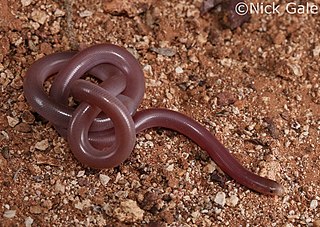
The Typhlopidae are a family of blind snakes. They are found mostly in the tropical regions of Africa, Asia, the Americas, and all mainland Australia and various islands. The rostral scale overhangs the mouth to form a shovel-like burrowing structure. They live underground in burrows, and since they have no use for vision, their eyes are mostly vestigial. They have light-detecting black eye spots, and teeth occur in the upper jaw. Typhlopids do not have dislocatable lower jaw articulations restricting them to prey smaller than their oral aperture. The tail ends with a horn-like scale. Most of these species are oviparous. Currently, 18 genera are recognized containing over 200 species.

Amerotyphlops brongersmianus, known commonly as Brongersma's worm snake or the South American striped blindsnake, is a species of harmless blind snake in the family Typhlopidae. The species is native to South America and Trinidad and Tobago in the Caribbean. No subspecies are currently recognized.

Indotyphlops braminus, commonly known as the brahminy blind snake and other names, is a non-venomous blind snake species found mostly in Africa and Asia, but has been introduced in many other parts of the world. They are completely fossorial animals, with habits and appearance similar to earthworms, for which they are often mistaken, although close examination reveals tiny scales rather than the annular segments characteristic of true earthworms. The species is parthenogenetic and all known specimens have been female. The specific name is a Latinized form of the word Brahmin. No subspecies are currently recognized.

Grypotyphlops acutus, also known as the beaked worm snake, beaked blind snake, or beak-nosed worm snake, is a harmless blind snake species endemic to peninsular India. It is the only species in the genus Grypotyphlops. No subspecies are currently recognized.
The Andaman worm snake is a species of harmless blind snake in the family Gerrhopilidae. The species is endemic to the Andaman Islands. No subspecies are currently recognized.
Beddome's worm snake is a species of harmless blind snake in the family Gerrhopilidae. The species is native to southern India. No subspecies are currently recognized.
Argyrophis diardii, known commonly as Diard's blind snake, the Indochinese blind snake, the large blind snake, or the large worm snake, is a species of harmless snake in the family Typhlopidae. The species is endemic to South Asia and Southeast Asia. There are two recognized subspecies.
Gerrhopilus thurstoni, or Thurston's worm snake, is a species of harmless blind snake in the family Gerrhopilidae. The species is native to western India. No recognized subspecies exist.
Gerrhopilus tindalli, also known commonly as the Nilgiri Hills worm snake or Tindall's worm snake, is a species of harmless blind snake in the family Gerrhopilidae. The species is native to southern India. There are no recognized subspecies.

Typhlops is a genus of blind snakes in the family Typhlopidae. The genus is endemic to the West Indies. Some species which were formerly placed in the genus Typhlops have been moved to the genera Afrotyphlops, Amerotyphlops, Anilios, Antillotyphlops, Argyrophis, Cubatyphlops, Indotyphlops, Letheobia, Madatyphlops, Malayotyphlops, and Xerotyphlops.
Letheobia is a genus of blind snakes in the family Typhlopidae.

Anilios endoterus is commonly known as the interior blind snake. It is one of 42 species of snake in the genus Anilios (Ramphotyphlops) from the Typhlopidae family living in Australia. These snakes appear to be blind, having vestigial eyes that are extremely sensitive to light. It is a cryptic burrowing snake that lives in tunnels underground, living mainly on a diet of ants. They are found in arid and semi-arid desert regions of central Australia and are considered endangered in New South Wales (NSW).
Fred Parker's blindsnake is a species of snake in the family Gerrhopilidae.
The Manila worm snake is a species of snake in the Gerrhopilidae family. It is sometimes placed in the genus Malayotyphlops.
Malayotyphlops koekkoeki, also known commonly as Koekkoek's blind snake or the Boenjoe Island worm snake, is a species of snake in the family Typhlopidae.
McDowell's blind snake is a species of snake in the family Gerrhopilidae.

Malayotyphlops ruficauda, commonly known as brown blind snake or red-headed worm snake, is a species of snake in the Typhlopidae family. It is endemic to the Philippines, where it is found on the islands of Luzon, Tablas and Marinduque.

Afrotyphlops schlegelii, commonly known as Schlegel's beaked blind snake or Schlegel's giant blind snake, is a species of snake in the family Typhlopidae. The species is endemic to eastern and southern Africa, and bears the distinction of being the world's largest typhlopid. It is harmless to humans and lives exclusively on a diet of termites.
Malayotyphlops is a genus of snakes in the family Typhlopidae.







